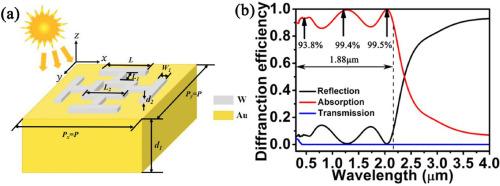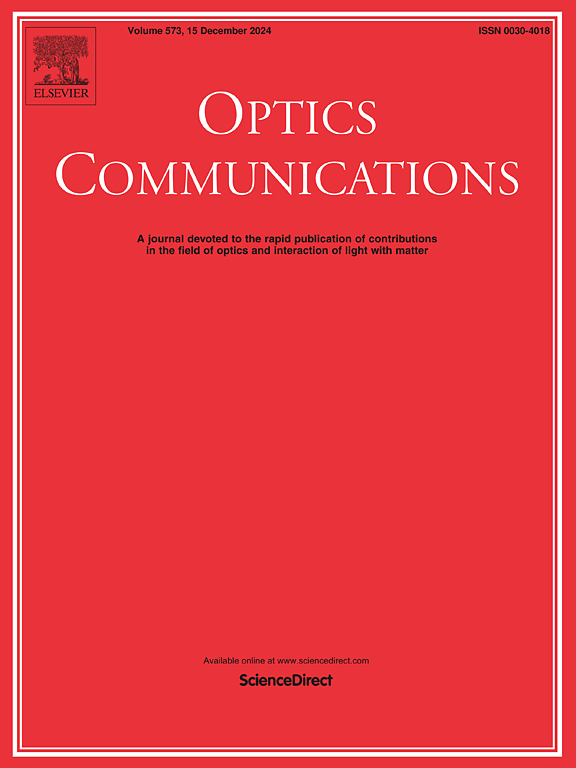超宽带、超高吸收、偏振无关和耐高温的超材料吸收器,用于太阳能热能收集应用
IF 2.2
3区 物理与天体物理
Q2 OPTICS
引用次数: 0
摘要
在这项工作中,设计了一种超宽带、超高吸收、偏振无关和耐高温的超材料吸收器,用于太阳能热能收集应用,并对其进行了数值模拟。所提出的纳米结构由沉积在金基底上的钨 (W) 材料的四个 T 形条带和方环纳米阵列结构组成。研究结果表明,该太阳能超材料吸收器可实现对太阳能的宽带吸收,带宽为 1.78 μm,在 0.4 μm 和 2.18 μm 的共振波长处吸收率超过 90%。也就是说,该太阳能吸收器具有超宽带和超高吸收的优异特性。太阳能吸收器的超宽带和超高吸收率是通过激发表面等离子体共振(SPR)实现的。在太阳能吸收器的设计中,可以通过优化纳米结构的几何形状(如改变 T 形条带和方环的几何尺寸以及阵列结构的周期等)来进一步提高其性能。无论是 TM 模式还是 TE 模式,太阳能超材料吸收器对入射角都不敏感,可在 0°-45° 入射角范围内使用。偏振角的变化也不会影响太阳能吸收器的吸收性能,具有良好的偏振无关性。此外,在 300 °C 至 1500 °C 的高温条件下,其光学特性几乎没有变化。研究发现,所设计的太阳能超材料吸收器不仅具有超宽带和超高吸收率,还具有优异的偏振无关性和耐高温性能。因此,这种吸收器在太阳能电池、光热转换和太阳热能收集应用中具有广阔的应用前景。本文章由计算机程序翻译,如有差异,请以英文原文为准。

Metamaterial absorber with ultra-broadband, ultra-high absorption, polarization independence and high-temperature resistance for solar thermal energy harvesting applications
In this work, a metamaterial absorber with ultra-broadband, ultra-high absorption, polarization independence and high-temperature resistance for solar thermal energy harvesting applications is designed and numerically simulated. The proposed nanostructure is composed of four T-shaped strips and square ring nanoarray structures of tungsten (W) material deposited on Au substrate. The findings demonstrate that the solar metamaterial absorber can attain broadband absorption of solar energy with a bandwidth of 1.78 μm and the absorption rate of over 90% at the resonance wavelengths of 0.4 μm and 2.18 μm. Namely, the solar absorber exhibits excellent features of ultra-broadband and ultra-high absorption. The ultra-broadband and ultra-high absorption rate of solar absorbers are achieved by exciting surface plasmon resonance (SPR). In the design of solar absorber, the performance can be further enhanced by optimizing the geometry of the nanostructure (e.g., changing the geometric dimensions of T-shaped strips and square rings, and the period of array structures, etc.). Whether in TM mode or TE mode, solar metamaterial absorbers are insensitive to incident angles and can be used within the range of 0°–45° incident angles. The variation of the polarization angle also does not affect the absorption performance of the solar absorber with good polarization independence. Furthermore, at high temperatures from 300 °C to 1500 °C, the optical properties hardly change. It is found that the designed solar metamaterial absorber not only has ultra-broadband and ultra-high absorption, but also has excellent performance of polarization independence and high-temperature resistance. Consequently, this absorber has a promising application in solar cells, photothermal conversion and solar thermal energy harvesting applications.
求助全文
通过发布文献求助,成功后即可免费获取论文全文。
去求助
来源期刊

Optics Communications
物理-光学
CiteScore
5.10
自引率
8.30%
发文量
681
审稿时长
38 days
期刊介绍:
Optics Communications invites original and timely contributions containing new results in various fields of optics and photonics. The journal considers theoretical and experimental research in areas ranging from the fundamental properties of light to technological applications. Topics covered include classical and quantum optics, optical physics and light-matter interactions, lasers, imaging, guided-wave optics and optical information processing. Manuscripts should offer clear evidence of novelty and significance. Papers concentrating on mathematical and computational issues, with limited connection to optics, are not suitable for publication in the Journal. Similarly, small technical advances, or papers concerned only with engineering applications or issues of materials science fall outside the journal scope.
 求助内容:
求助内容: 应助结果提醒方式:
应助结果提醒方式:


